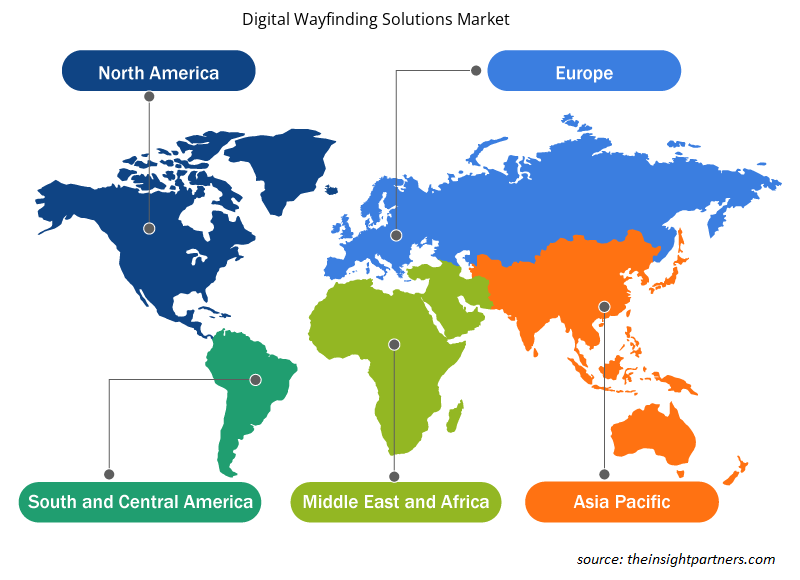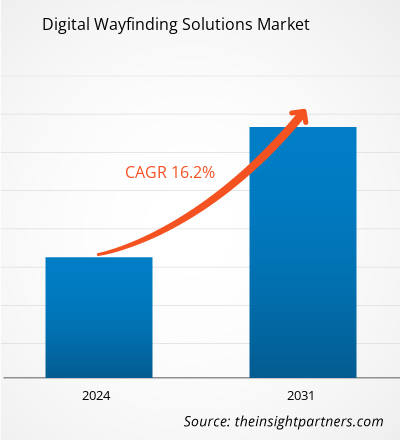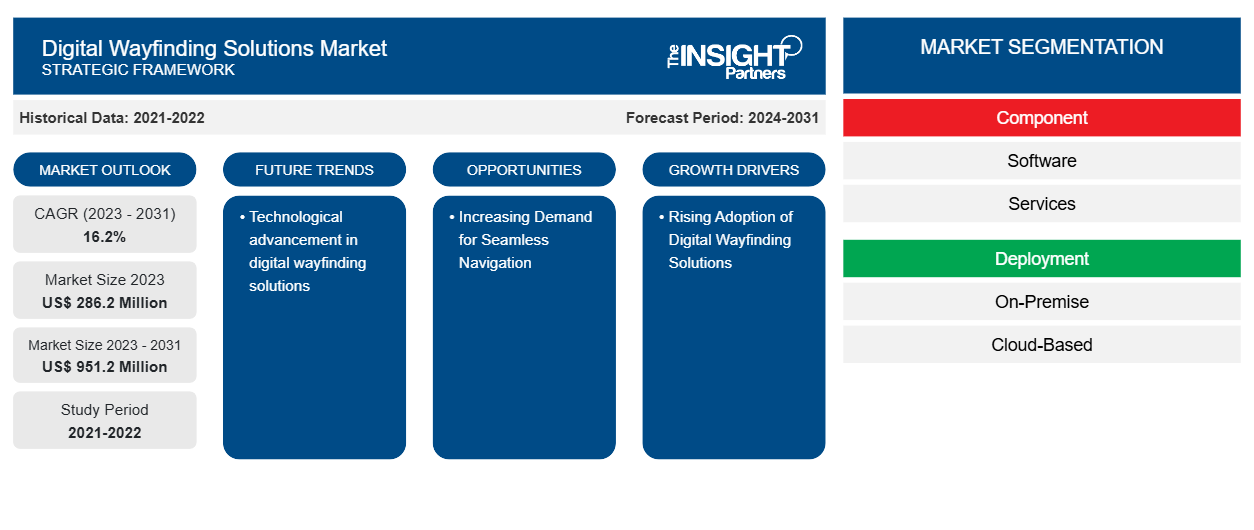Der Markt für digitale Wegfindungslösungen soll von 286,2 Millionen US-Dollar im Jahr 2023 auf 951,2 Millionen US-Dollar im Jahr 2031 anwachsen. Der Markt wird zwischen 2023 und 2031 voraussichtlich eine durchschnittliche jährliche Wachstumsrate (CAGR) von 16,2 % verzeichnen. Der technologische Fortschritt bei digitalen Wegfindungslösungen dürfte ein wichtiger Trend auf dem Markt bleiben.
Marktanalyse für digitale Wegfindungslösungen
Digitale Wegweiser liefern Unternehmen hervorragende Datenanalysen und Einblicke. Diese Daten umfassen Informationen zu Stoßzeiten, beliebten Routen und häufigen Besuchen von Bereichen. In einem Einkaufszentrum kann das System den Fußgängerverkehr verfolgen, um stark frequentierte Bereiche zu lokalisieren. So können Unternehmen Werbedisplays strategisch platzieren oder Ladenlayouts optimieren, um die Sichtbarkeit und den Umsatz zu steigern. Darüber hinaus hilft die Verfolgung des Nutzerverhaltens in digitalen Wegweisersystemen Unternehmen dabei, zu verstehen, wie Einzelpersonen mit dem System interagieren. In einer Museumsumgebung kann die Verfolgung der Benutzerpräferenzen für Ausstellungsbesuche den Besuchern Informationen über Besucherpräferenzen geben. Diese Informationen helfen Kuratoren dabei, zukünftige Ausstellungen zu erstellen, die beliebte Themen ergänzen und das Besuchererlebnis verbessern.
Marktübersicht für digitale Wegfindungslösungen
Die digitale Wegfindung nutzt Technologien wie interaktive Karten, Touchscreens und mobile Apps, um Personen bei der Orientierung in Innen- und Außenbereichen zu unterstützen. Sie hat traditionelle Methoden der Wegfindung deutlich verbessert, indem sie Technologien zur Bereitstellung dynamischer und personalisierter Navigationslösungen in Echtzeit nutzt. Im Gegensatz zu statischen Beschilderungen bieten digitale Bildschirme aktuelle Informationen in Echtzeit, sodass Benutzer auf die genauesten und präzisesten Wegbeschreibungen zugreifen können. Der Flughafen nutzt fortschrittliche digitale Wegfindungssysteme, um Passagieren eine nahtlose Navigation durch Terminals, Gates und Einrichtungen zu ermöglichen. Obwohl er einer der überfülltesten Flughäfen der Welt ist, zielt die Einführung dieser hochmodernen Systeme darauf ab, die allgemeine Kommunikation und Betriebseffizienz zu verbessern.
Passen Sie diesen Bericht Ihren Anforderungen an
Sie erhalten kostenlose Anpassungen an jedem Bericht, einschließlich Teilen dieses Berichts oder einer Analyse auf Länderebene, eines Excel-Datenpakets sowie tolle Angebote und Rabatte für Start-ups und Universitäten.
-
Holen Sie sich die wichtigsten Markttrends aus diesem Bericht.Dieses KOSTENLOSE Beispiel umfasst eine Datenanalyse von Markttrends bis hin zu Schätzungen und Prognosen.
Markttreiber und Chancen für digitale Wegfindungslösungen
Steigende Akzeptanz digitaler Wegfindungslösungen begünstigt den Markt
Digitale Wegfindungslösungen haben eine breite Palette gängiger Anwendungsfälle in verschiedenen Branchen und Umgebungen. Zu den häufigsten Anwendungsfällen zählen: Flughäfen, Einkaufszentren, Krankenhäuser und Gesundheitseinrichtungen, Bildungseinrichtungen , Ausstellungs- und Kongresszentren, Museen und Kultureinrichtungen und viele mehr. Flughäfen verwenden digitale Wegfindungslösungen, um Reisenden dabei zu helfen, sich in Terminals zurechtzufinden, ihre Gates zu finden, Gepäckausgabebereiche zu lokalisieren und Flughafeneinrichtungen zu nutzen. Diese Lösungen umfassen oft Fluginformationen in Echtzeit, Wartezeiten an Sicherheitskontrollen und Informationen zu Diensten wie Restaurants und Geschäften. Digitale Wegfindungslösungen liefern Informationen zum Benutzerverhalten, beispielsweise beliebte Routen, häufig besuchte Bereiche und Navigationsmuster. Diese Daten können analysiert werden, um Einblicke in Benutzerpräferenzen, Verkehrsfluss und die allgemeine Nutzung der Einrichtungen zu erhalten, sodass Organisationen datengesteuerte Entscheidungen treffen und ihre Räumlichkeiten optimieren können.wayfinding solutions have a wide range of common use cases in various industries and environments. Some of the most prevalent use cases include: airports, shopping malls, hospitals and healthcare facilities, wayfinding solutions to help travelers navigate terminals, find their gates, locate baggage claim areas, and access airport amenities. These solutions often include real-time flight information, security checkpoint wait times, and information on services like restaurants and shops. Digital wayfinding solutions provide information on user behavior, such as popular routes, frequently visited areas, and navigation patterns. This data can be analyzed to gain insights into user preferences, traffic flow, and overall facility usage, enabling organizations to make data-driven decisions and optimize their spaces.
Steigende Nachfrage nach nahtloser Navigation
Die digitale Wegweisung ermöglicht mühelose Navigation, klare Anweisungen und eine bequeme Möglichkeit für Benutzer, sich in Flughäfen, Einkaufszentren, Krankenhäusern und mehr zurechtzufinden. Eine klare und prägnante Wegweisung verbessert das allgemeine Benutzererlebnis, indem sie Stress, Frustration und Verwirrung reduziert. Ob man sich in einem belebten Bahnhof oder einem weitläufigen Firmengelände zurechtfindet, intuitive Beschilderungssysteme geben Besuchern und Mitarbeitern gleichermaßen Sicherheit und Vertrauen. Es ist schwierig, sich in einem weitläufigen Einkaufszentrum zurechtzufinden, aber Indoor-Karten können den Vorgang vereinfachen. Käufer können problemlos ihre gewünschten Geschäfte finden, Annehmlichkeiten wie Toiletten und Rolltreppen finden und den kürzesten Weg zu ihren Zielen planen. Ob es sich um einen Erstbesucher oder einen Stammbesucher handelt, Indoor-Karten ermöglichen eine nahtlose und stressfreie Reise durch das komplexe Layout des Einkaufszentrums. Mit der Weiterentwicklung der Technologie werden durch die Einbeziehung digitaler Wegweisungslösungen und interaktiver Displays die Fähigkeiten und die Wirksamkeit von Wegweisungs-Beschilderungssystemen weiter verbessert und eine neue Ära der nahtlosen Navigation für alle eingeläutet.wayfinding provides effortless navigation, clear directions, and a convenient way for users to navigate airports, shopping malls, hospitals, and more.Clear and concise wayfinding enhances the overall user experience by reducing stress, frustration, and confusion. Whether navigating a busy train station or a sprawling corporate campus, intuitive signage systems provide peace of mind and confidence to visitors and employees alike. It's difficult to navigate a sprawling shopping mall, but indoor maps can simplify the process. Shoppers can easily locate their desired stores, locate amenities such as bathrooms and escalators, and chart the shortest route to their destinations. Whether it's a first-time visitor or a regular visitor, indoor maps provide a seamless and stress-free journey throughout the mall's intricate layout. As technology evolves, incorporating digital wayfinding solutions and interactive displays will further enhance the capabilities and effectiveness of wayfinding signage systems, ushering in a new era of seamless navigation for all.
Marktbericht zu digitalen Wegfindungslösungen – SegmentierungsanalyseWayfinding Solutions Market Report Segmentation Analysis
Wichtige Segmente, die zur Ableitung der Marktanalyse für digitale Wegfindungslösungen beigetragen haben, sind Komponente, Bereitstellung und Endbenutzer.wayfinding solutions market analysis are component, deployment, and end user.
- Basierend auf den Komponenten ist der Markt für digitale Wegfindungslösungen in Software und Dienstleistungen segmentiert.wayfinding solutions market is segmented into software and services.
- Nach Bereitstellung ist der Markt in On-Premise und Cloud-basiert segmentiert.
- Hinsichtlich der Anwendung ist der Markt in Flughäfen, Einzelhandel, Gesundheitswesen, Museen und Sonstige segmentiert.
Marktanteilsanalyse für digitale Wegfindungslösungen nach geografischer Lage
Der geografische Umfang des Marktberichts für digitale Wegfindungslösungen ist hauptsächlich in fünf Regionen unterteilt: Nordamerika, Asien-Pazifik, Europa, Naher Osten und Afrika sowie Süd- und Mittelamerika. Die Cleveland Clinic ist ein bemerkenswertes medizinisches Zentrum in den Vereinigten Staaten, das ein Hightech-System implementiert hat, um Patienten und Besuchern bei der Navigation auf dem komplexen Campus zu helfen. Dieses digitale Wegfindungssystem nutzt interaktive Touchscreens und mobile Apps, um Patienten Schritt-für-Schritt-Anweisungen zu Kliniken, Abteilungen und Patientenzimmern zu geben.
Regionale Einblicke in den Markt für digitale Wegfindungslösungen
Die regionalen Trends und Faktoren, die den Markt für digitale Wegfindungslösungen während des gesamten Prognosezeitraums beeinflussen, wurden von den Analysten von Insight Partners ausführlich erläutert. In diesem Abschnitt werden auch die Marktsegmente und die Geografie digitaler Wegfindungslösungen in Nordamerika, Europa, im asiatisch-pazifischen Raum, im Nahen Osten und Afrika sowie in Süd- und Mittelamerika erörtert.

- Erhalten Sie regionale Daten zum Markt für digitale Wegfindungslösungen
Umfang des Marktberichts zu digitalen Wegfindungslösungen
| Berichtsattribut | Details |
|---|---|
| Marktgröße im Jahr 2023 | 286,2 Millionen US-Dollar |
| Marktgröße bis 2031 | 951,2 Millionen US-Dollar |
| Globale CAGR (2023 - 2031) | 16,2 % |
| Historische Daten | 2021-2022 |
| Prognosezeitraum | 2024–2031 |
| Abgedeckte Segmente |
Nach Komponente
|
| Abgedeckte Regionen und Länder |
Nordamerika
|
| Marktführer und wichtige Unternehmensprofile |
|
Marktteilnehmerdichte für digitale Wegfindungslösungen: Auswirkungen auf die Geschäftsdynamik verstehen
Der Markt für digitale Wegfindungslösungen wächst rasant, angetrieben von der steigenden Nachfrage der Endnutzer aufgrund von Faktoren wie sich entwickelnden Verbraucherpräferenzen, technologischen Fortschritten und einem größeren Bewusstsein für die Vorteile des Produkts. Mit steigender Nachfrage erweitern Unternehmen ihr Angebot, entwickeln Innovationen, um die Bedürfnisse der Verbraucher zu erfüllen, und nutzen neue Trends, was das Marktwachstum weiter ankurbelt.
Die Marktteilnehmerdichte bezieht sich auf die Verteilung der Firmen oder Unternehmen, die in einem bestimmten Markt oder einer bestimmten Branche tätig sind. Sie gibt an, wie viele Wettbewerber (Marktteilnehmer) in einem bestimmten Marktraum im Verhältnis zu seiner Größe oder seinem gesamten Marktwert präsent sind.
Die wichtigsten Unternehmen auf dem Markt für digitale Wegfindungslösungen sind:
- Digital erwerben
- Klicken Sie auf Grafix
- ConnectedSign
- DIGITALE WEGWEISUNGSLÖSUNGEN
- Jarma Technologies LLP
- MetroClick
Haftungsausschluss : Die oben aufgeführten Unternehmen sind nicht in einer bestimmten Reihenfolge aufgeführt.

- Überblick über die wichtigsten Akteure auf dem Markt für digitale Wegfindungslösungen
Marktnachrichten und aktuelle Entwicklungen zu digitalen Wegfindungslösungen
Der Markt für digitale Wegfindungslösungen wird durch die Erhebung qualitativer und quantitativer Daten nach Primär- und Sekundärforschung bewertet, die wichtige Unternehmensveröffentlichungen, Verbandsdaten und Datenbanken umfasst. Nachfolgend sind einige der Entwicklungen auf dem Markt für digitale Wegfindungslösungen aufgeführt:
- 22Miles Inc. gab heute die Einführung von Digital Signage Ready (DSR) bekannt, einer Sammlung gebrauchsfertiger Software- und Servicepakete, die die Einrichtung und Bereitstellung der beliebtesten Digital Signage-Erlebnisse vereinfachen. (Quelle: 22Miles Inc., Juli 2021)
- Acquire Digital hat eine digitale Wegweiser- und Verzeichnislösung für die bevorstehende Lebensmittelfachmesse auf den Markt gebracht. Die branchenführende interaktive Wegweiser- und Indoor-Navigationsplattform von Acquire Digital wird eingesetzt, um den Teilnehmern dabei zu helfen, sich auf der Messe zurechtzufinden, Veranstaltungen zu erkunden und andere wichtige Ausstellungsmaterialien zu entdecken. (Quelle: Acquire Digital, September 2021)
Marktbericht zu Lösungen zur digitalen Wegfindung – Abdeckung und Ergebnisse
Der Bericht „Marktgröße und Prognose für digitale Wegfindungslösungen (2021–2031)“ bietet eine detaillierte Analyse des Marktes, die die folgenden Bereiche abdeckt:
- Marktgröße und Prognose für digitale Wegfindungslösungen auf globaler, regionaler und Länderebene für alle wichtigen Marktsegmente, die im Rahmen des Geltungsbereichs abgedeckt sind
- Markttrends und Marktdynamiken für digitale Wegfindungslösungen wie Treiber, Einschränkungen und wichtige Chancen
- Detaillierte PEST/Porters Five Forces- und SWOT-Analyse
- Marktanalyse für digitale Wegfindungslösungen mit Blick auf wichtige Markttrends, globale und regionale Rahmenbedingungen, wichtige Akteure, Vorschriften und aktuelle Marktentwicklungen
- Branchenlandschaft und Wettbewerbsanalyse, die die Marktkonzentration, Heatmap-Analyse, prominente Akteure und aktuelle Entwicklungen auf dem Markt für digitale Wegfindungslösungen umfasst
- Detaillierte Firmenprofile
- Historische Analyse (2 Jahre), Basisjahr, Prognose (7 Jahre) mit CAGR
- PEST- und SWOT-Analyse
- Marktgröße Wert/Volumen – Global, Regional, Land
- Branchen- und Wettbewerbslandschaft
- Excel-Datensatz
Aktuelle Berichte
Verwandte Berichte
Erfahrungsberichte
Grund zum Kauf
- Fundierte Entscheidungsfindung
- Marktdynamik verstehen
- Wettbewerbsanalyse
- Kundeneinblicke
- Marktprognosen
- Risikominimierung
- Strategische Planung
- Investitionsbegründung
- Identifizierung neuer Märkte
- Verbesserung von Marketingstrategien
- Steigerung der Betriebseffizienz
- Anpassung an regulatorische Trends























 Kostenlose Probe anfordern für - Markt für digitale Wegfindungslösungen
Kostenlose Probe anfordern für - Markt für digitale Wegfindungslösungen